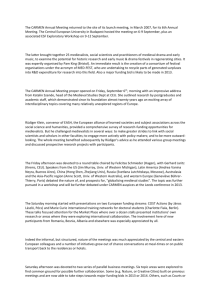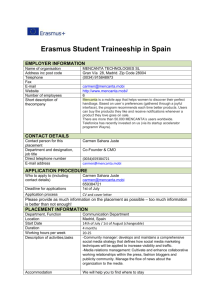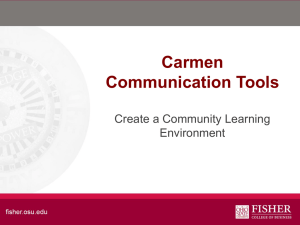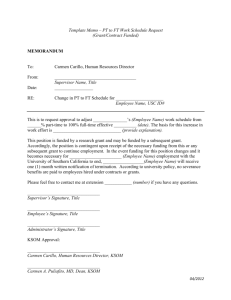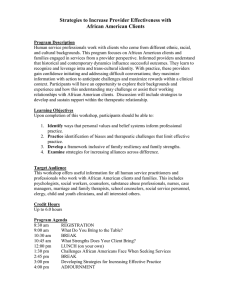BUSMGT 7251 Managing Product and Process Innovation (Subjected to some changes)
advertisement
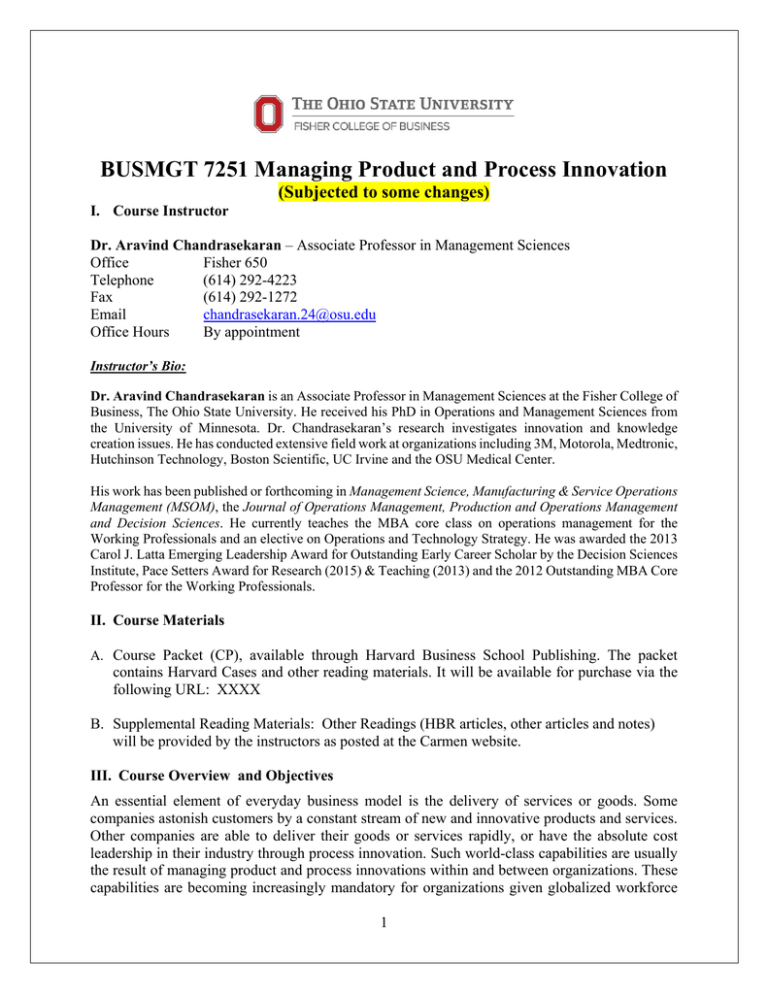
BUSMGT 7251 Managing Product and Process Innovation (Subjected to some changes) I. Course Instructor Dr. Aravind Chandrasekaran – Associate Professor in Management Sciences Office Fisher 650 Telephone (614) 292-4223 Fax (614) 292-1272 Email chandrasekaran.24@osu.edu Office Hours By appointment Instructor’s Bio: Dr. Aravind Chandrasekaran is an Associate Professor in Management Sciences at the Fisher College of Business, The Ohio State University. He received his PhD in Operations and Management Sciences from the University of Minnesota. Dr. Chandrasekaran’s research investigates innovation and knowledge creation issues. He has conducted extensive field work at organizations including 3M, Motorola, Medtronic, Hutchinson Technology, Boston Scientific, UC Irvine and the OSU Medical Center. His work has been published or forthcoming in Management Science, Manufacturing & Service Operations Management (MSOM), the Journal of Operations Management, Production and Operations Management and Decision Sciences. He currently teaches the MBA core class on operations management for the Working Professionals and an elective on Operations and Technology Strategy. He was awarded the 2013 Carol J. Latta Emerging Leadership Award for Outstanding Early Career Scholar by the Decision Sciences Institute, Pace Setters Award for Research (2015) & Teaching (2013) and the 2012 Outstanding MBA Core Professor for the Working Professionals. II. Course Materials A. Course Packet (CP), available through Harvard Business School Publishing. The packet contains Harvard Cases and other reading materials. It will be available for purchase via the following URL: XXXX B. Supplemental Reading Materials: Other Readings (HBR articles, other articles and notes) will be provided by the instructors as posted at the Carmen website. III. Course Overview and Objectives An essential element of everyday business model is the delivery of services or goods. Some companies astonish customers by a constant stream of new and innovative products and services. Other companies are able to deliver their goods or services rapidly, or have the absolute cost leadership in their industry through process innovation. Such world-class capabilities are usually the result of managing product and process innovations within and between organizations. These capabilities are becoming increasingly mandatory for organizations given globalized workforce 1 and new world economy. The purpose of BUSMGT 7251 is to develop a unifying framework for analyzing product and process innovation in manufacturing and service operations. The course uses theory and cases to illustrate and explore the concept of product and process innovation. It takes an S-curve approach to understand product and process innovation challenges as organizations move from introductory, growth to mature stages of product lifecycles. It also develops frameworks to manage these challenges. IV. Course Objectives The specific learning objectives for this course include: To develop an understanding of various product and process innovation challenges in your organization To further the students’ ability to think strategically, analytically and creatively on various innovation issues To create a structured approach to develop a new product, process or service and understand the challenges from design to launch. To develop a better understanding how to organizations manage today’s needs and tomorrow’s growth To apply frameworks discussed to assessing their organization’s innovative capabilities V. Bases for Grading A. Distribution 40% Final Exam (Take home) 40% Critiques (Four Critiques each weighted @ 10%) 20% Class Participation, In Class Experiments B. Final Examinations Final Examination will be a combination of case analyses and short essay answers. The material for these exams can be based on anything covered in the lecture, text, other assigned readings and videos and guest presentations. More details regarding the exam will be given on day 1 of the class. C. Cases and Exercises A combination of Harvard Business Cases, Harvard Business Review (HBR) articles and other cases will be used to guide our class discussions. You are expected to read these cases before class. Most of your learning will occur in preparing and discussing these cases in class. Case discussions will be a huge component of your class participation points. During these discussions, we will also spend some time evaluating your organization’s (current or previous) operational capabilities 2 based on these topics. Therefore, it is necessary to reflect on these readings and gather some background knowledge before coming to class. D. Critiques & Case Analyses There will be four critiques that are due at various points during the course. Students are required to turn in these critiques as a group assignment. Groups are to consist of up to 4 students only. Any exceptions must be approved in advance. The purpose of these critiques is to apply the class readings to a particular mini-case or a context described in a vignette. All these vignettes and minicases are based on problems observed by me or my co-authors during our research (or consulting) in a variety of industry context including technology sector, healthcare, manufacturing and banking. Critiques should not be more than 4-pages (single-spaced) with an additional page or two for other supplemental material (e.g. frameworks, figures, calculations etc.). More details will be given during the first week of class. E. Class Participation, Simulation and In Class Experiments Your class participation grade will primarily depend on the quality of comments made during class, particularly during case discussions. Quality of participation, i.e. insightful comments or questions, is much more important than quantity. Also, a consistent level of participation throughout the quarter will receive a much higher score than a high level of participation for just a few classes. You are encouraged to check with me periodically to find about your participation grade. The following class participation rubric has been developed to evaluate the class participation. Participation is graded on a scale from 0 (lowest) through 4 (highest), using the criteria below. The criteria focus on what you demonstrate in class. VI. Honor Code Any use of case analyses or any other material in any format from other sections of this course or any course taught at any time in the past or present will be considered a violation of the honor code. The Ohio State University and the Committee on Academic Misconduct (COAM) expect that all students have read and understand the University’s Code of Student Conduct, and that all students will complete all academic and scholarly assignments with fairness and honesty. Students must recognize that failure to follow the rules and guidelines established in the University’s Code of Student Conduct and this syllabus may constitute “Academic Misconduct.” VII. Disability Accommodation If you need an accommodation based on the impact of a disability, please arrange an appointment with one of the instructors as soon as possible. We need to discuss the course format and explore potential accommodations. We rely on the Office for Disability Services (150 Pomerene Hall) for assistance in verifying need and developing accommodation strategies. You should start the verification process as soon as possible. 3 Class Schedule Readings found in Course Packet (CP) or posted at Carmen Website (Refer Detailed syllabus for class structure and discussion questions) Introduction to Product and Process Innovation Wednesday (October 21) Session 1: Introduction to Product and Process Innovation Read: Reinvent your Business before its Too Late: Watch out for Those S-curves (CP) Due (after class): List of Team Members with Contact Information Session 2: Managing Product and Process Portfolios Read: Creating Project Plans to Focus Product Development (Carmen) Skim: The Role of Organizational and Project Context for High-Tech R&D Projects (Carmen) Front-end of the S-curve Wednesday (October 28) Session 1: Innovation and Uncertainty Read: The Fate of the Vasa (CP) Skim: Managing R&D Project Shifts in High-Tech Organizations (Carmen) Session 2: Operational Strategy for Innovation – II Read: Innovation at 3M (CP) – Lead User Methodology Due: Critique 1 (See Carmen) Wednesday (November 4) Session 1: Disruptive Innovation Challenges Read: Catching the Disruptive Wave (Carmen) Session 2: Open Innovation Read: Open Innovation at Siemens Due: Critique 2 (See Carmen) Ramp-up your S-curves: From Concepts to Execution – Challenges and Opportunities Wednesday (November 18) Session 1: Managing Tradeoffs in Manufacturing Read: Eli-Lilly and Company: The Flexible Facility Decision (CP) Session 2: Managing Tradeoffs in Services Read: Ritten-House Medical Center (CP) Due: Critique 3 (see Carmen) Wednesday (December 2) Session 1: Process Innovation at Cardinal Health Speaker: Mr. Chris Dillinger – Director Cardinal Health Session 2: Managing Innovation during Growth Read: Jet Blue Airways: Managing Growth (CP) 4 Due: Critique 4 (see Carmen) Final Section: Supply Chain & Social Innovation Wednesday (December 9) Session 1: Process Design for External Innovation Read: Restoring American Competitiveness (Carmen) Skim: Does America Really Needs Manufacturing? (Carmen) Session 2: Social Innovation & Course Wrap-up Read: Samasource: Give Work, Not Aid (CP) Date and Time TBD - Final Exam 5 Managing Product and Process Innovation: Detailed Course Outline October 21 Introduction to Product and Process Innovation Session 1 Readings: Reinvent your business before it’s too late: Watch out for those S-curves Session 2 Readings: Creating Project Plans to Focus Product Development (Carmen) Skim: The Role of Organizational and Project Context in Managing High-Tech R&D projects (Carmen) Class Topics & Key Learning Concepts: Welcome and introductions class structure, procedures and assignments. Challenges at various parts of the S-curves. How to manage different types of Innovation Designing team and organizational context Team Formation and Preparation for Upcoming Team Assignment. → Due: List of Team Members with Contact Information October 28 Innovation and Uncertainty Session 1 Readings: Case: The Fata of the Vasa (CP) Skim: Managing R&D Project Shifts in High-Tech Organizations: A Multi-Method Study (Carmen) Discussion Questions: 1. Why did the Vasa meet this fate? 2. What could have been done to avoid this fate? Session 2 Readings: Case: Innovation at 3M (CP) Case Discussion Questions: 1. How has 3M’s innovation process evolved since the company was founded? Why, if at all does 3M, known as a ‘hothouse’ of innovation, need to regain its historic closeness to the customer? 2. How does Lead User research process differ from and complement other traditional marker research methods? 3. Has the Medical-Surgical team applied the lead user research process successfully? Why and Why not? 4. What should the Medical-Surgical Lead User team recommend to Dunlop: the three new product concepts or a new business strategy? What are the risks of the new lead user process at 3M? What are the risks to the medical-surgical business unit? 6 Class Topics and Key Learning Concepts: Project termination and alteration decisions Introduction to performance landscape Introduction to lead-user innovation – pros and cons How to manage lead-user research → Due: Critique 1 (See Carmen) November 4 Disruptive Innovation & Open Innovation Session 1 Readings: HBR: Disruptive Technology: Catching the wave (Carmen) Discussion Questions tied to Readings 1. What is disruptive innovation? What are other examples on disruptive innovation (especially in a service context)? 2. How could we identify disruptive innovation? 3. How to operationally manage disruptive innovation? Session 2 Readings: Case: Open Innovation at Siemens (CP) Discussion Questions tied to Readings 1. Why did Siemens create an open innovation initiative? What perceived problems was the initiative trying to solve? 2. What metrics should be used to assess effectiveness of open innovation at Siemens? What should be used in your firm? 3. Should the responsibility of open innovation be centralized or decentralized? Class Topics and Key Learning Concepts: Introduction to disruptive innovation How to assess an innovation is disruptive or not? Introduction to open innovation → Due: Critique 2 (See Carmen) November 18 Managing Tradeoffs in Mfg and Services Session 1 Readings Case: Eli Lilly and Company: The Flexible Facility Decision (CP). Case Discussion Questions: 1. How has the competitive environment in pharmaceuticals been changing over the past few years? What are the implications for the role of manufacturing with Eli Lilly? 2. How does each facilities option affect Lilly’s cost structure capacity management and product development capabilities? 3. What type of flexibility does the “flexible facility” provide? What is the value of this flexibility to Eli Lilly? How much is Lilly paying for this flexibility? 7 4. Given Lilly’s strategic goals, which option should Steve Mueller recommend? Are there other options that Lilly should be contemplating? Is so, what are they? Session 2 Readings Case: Managing Orthopaedics at Rittenhouse Medical Center (CP) Case Discussion Questions: 1. What is your assessment of the 3B Orthopaedics model relative to that used for typical procedures performed by the faculty practice surgeons? Which is better? What are the key criteria for your assessment? 2. What are the possible sources of conflict between the two models of care? How might they be reduced? Class Topics and Key Learning Concepts: Flexibility vs. Efficiency – how to decide on the right operational objective Understand the concept of tradeoff in operations. How to avoid tradeoffs? Concept of Focus and Multi-specialty operations → Due: Critique 3 (See Carmen) December 2 Process Innovation & Growth Challenges Session 1: Guest Speaker – Mr. Chris Dillinger (Cardinal Health) “Process Innovation Challenges and Lessons” Session 2: Growth Challenges Case: Jet Blue Airways: Managing Growth (CP) Case Discussion Questions: 1. How would you describe JetBlue’s operations strategy prior to November 2005 adoption of the E190? 2. Compare the economics of the E190 and A320 for Jet Blue? What are the key drivers of profitability for each type of plane? 3. Do you agree with JetBlue’s decision to add E190 to its fleet? What is the rationale for your decision? 4. How should JetBlue slow down the growth of its fleet? Should it cut growth in A320 capacity or E190 capacity or both? Key Learning Concepts: Understand the strategic implications of growth through operational diversification. Challenges associated with slowing growth of a young firm. Challenges in using extensions to achieve growth. → Due: Critique 1 (See Carmen) December 9 Supply Chain and Social Innovation Session 1 Readings: HBR: Restoring American Competitiveness (Carmen) 8 Skim: Does American Really Need Manufacturing? (Carmen) Key Learning Concepts Strategies for outsourcing, offshoring. When to Offshore/ Outsource your R&D? R&D and Manufacturing Connections Session 2 Readings Case: Samasource – Give Work Not Aid Case Discussion Questions: 1. How should Samasource fund their growth going forward? Should the company create separate for-profit and non-profit business? Why? 2. Why doesn’t Samasource own their delivery centers when most competitors do? Is this a good choice going forward? 3. How can Samasource manage improvement & learning in their delivery centers going forward? 4. How can Samasource continue to acquire top talent? What is the recruiting pitch that you would make as Leila? Key Learning Concepts: Issues in applying innovation models and approaches to the social sector. Microwork and Operations. Operations in not-profit settings. TBD FINAL EXAM 9
